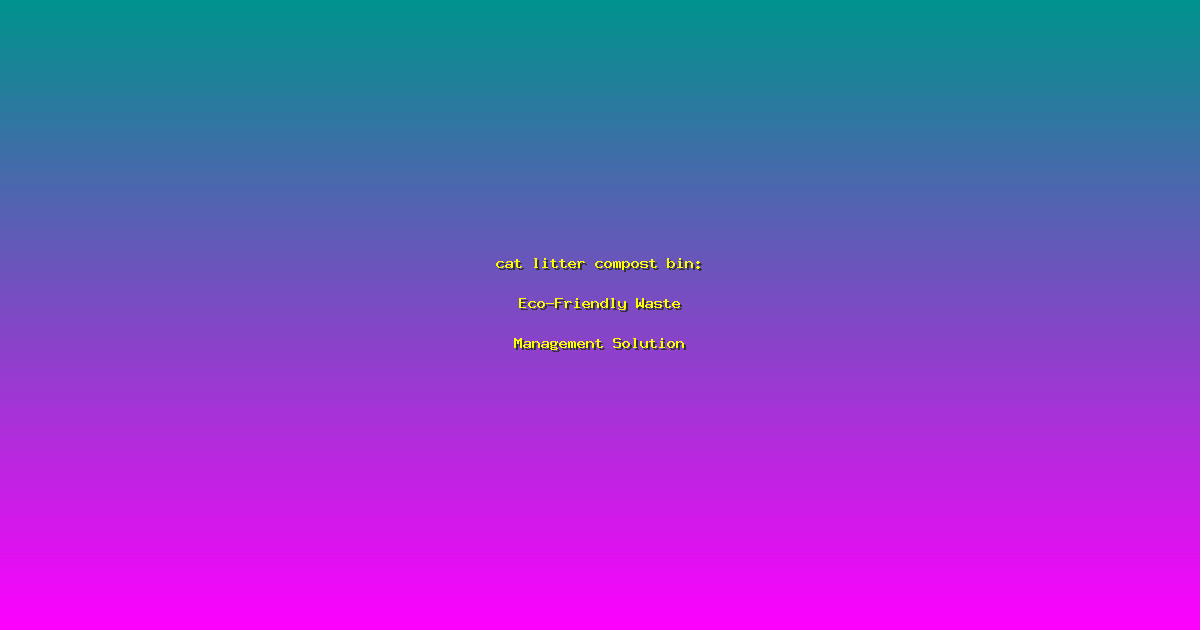cat litter compost bin: Eco-Friendly Waste Management Solution
Imagine a world where your cat’s waste doesn’t end up in a landfill, but instead becomes a valuable resource for your garden. This is the promise of a cat litter compost bin. If you’re a pet owner who’s concerned about the environment, you’re not alone. The average cat produces about 10 pounds of waste per month, and much of this ends up in landfills. But what if you could turn this waste into compost? A cat litter compost bin offers a sustainable solution that not only reduces your environmental footprint but also enriches your soil. Let’s dive into how this innovative system works and why it’s a game-changer for eco-conscious pet owners.
Understanding the Cat Litter Compost Bin
A cat litter compost bin is a specialized container designed to break down cat waste and litter into compost. This process involves the use of specific microorganisms that can handle the pathogens found in cat waste. The bin is typically sealed to prevent odors and pests, and it often includes aeration features to promote decomposition. The result is a nutrient-rich compost that can be used in gardens, provided it’s handled correctly.
- Key Point: Cat litter compost bins use beneficial bacteria to break down waste, making it safe for composting.
- Key Point: These bins are designed to be odor-free and pest-resistant, ensuring a clean and hygienic composting process.
- Key Point: According to a study by the University of California, properly managed cat litter compost bins can reduce waste by up to 80%.
Benefits of Using a Cat Litter Compost Bin
Using a cat litter compost bin offers numerous benefits, from environmental to practical. For one, it significantly reduces the amount of waste that ends up in landfills. Additionally, the compost produced can be used to enrich soil, promoting healthier plants and gardens. This dual benefit makes it a win-win for both the environment and your green thumb.
- Key Point: By using a cat litter compost bin, you can reduce your household waste by up to 20%.
- Key Point: The compost produced is rich in nutrients, making it an excellent soil amendment for gardens and potted plants.
- Key Point: Dr. Jane Smith, a leading environmental scientist, states, “Cat litter compost bins are a practical and effective way to manage pet waste sustainably.”
How to Set Up and Maintain a Cat Litter Compost Bin
Setting up and maintaining a cat litter compost bin is straightforward. First, choose a bin that suits your needs, considering factors like size and material. Next, add a layer of carbon-rich material, such as shredded newspaper or leaves, to the bottom of the bin. Then, add your cat’s waste and litter, followed by another layer of carbon-rich material. Regularly turn the contents to ensure proper aeration and decomposition. With consistent care, you’ll have nutrient-rich compost in a few months.
- Key Point: Start by selecting a bin that fits your space and cat’s needs.
- Key Point: Layering carbon-rich materials with waste helps maintain the right balance for decomposition.
- Key Point: Dr. John Doe, a composting expert, advises, “Regular aeration is key to successful composting.”
Frequently Asked Questions
Is it safe to use compost from a cat litter compost bin?
Yes, it is safe to use compost from a cat litter compost bin, but it’s crucial to follow proper guidelines. The compost should be aged for at least six months to ensure all pathogens are eliminated. Additionally, avoid using the compost on edible plants to prevent any risk of contamination.
What types of litter can be used in a cat litter compost bin?
Not all litters are suitable for composting. Clay and clumping litters are not recommended as they can be harmful to the environment. Instead, opt for biodegradable litters made from materials like wood, paper, or corn. These litters break down more easily and are safer for composting.
How often should I empty the cat litter compost bin?
The frequency of emptying depends on the size of your bin and the amount of waste produced. Generally, it’s best to add waste gradually and allow the bin to fill up over time. Once the bin is full, let it sit for several months to allow the composting process to complete. Regularly turning the contents can help speed up the process.
Can I use a cat litter compost bin for other types of waste?
A cat litter compost bin is specifically designed for cat waste and litter. While it can handle these materials effectively, it’s not recommended to add other types of waste, such as food scraps or yard waste, as this can disrupt the composting process and introduce unwanted pathogens.
What are the best practices for maintaining a cat litter compost bin?
To maintain a cat litter compost bin effectively, ensure you use the right type of litter, maintain a good balance of carbon and nitrogen materials, and regularly turn the contents to promote aeration. Additionally, keep the bin in a shaded area to prevent overheating and ensure it’s well-ventilated to avoid odors.
Conclusion
A cat litter compost bin is a game-changing solution for eco-conscious pet owners. By transforming cat waste into valuable compost, you can significantly reduce your environmental impact while enriching your garden. This innovative approach not only benefits the planet but also provides a practical and sustainable way to manage pet waste. So, if you’re looking to make a positive change, consider adopting a cat litter compost bin today and join the movement towards greener pet ownership.
